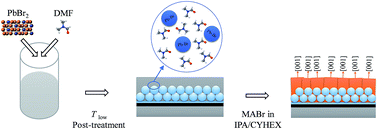An amorphous precursor route to the conformable oriented crystallization of CH3NH3PbBr3 in mesoporous scaffolds: toward efficient and thermally stable carbon-based perovskite solar cells†
Abstract
CH3NH3PbBr3 (MAPbBr3)-perovskite solar cells (Br-PSCs) have attracted much attention due to their green-long wavelength transparency and high open-circuit voltage originating from their large bandgap (2.2 eV). However, the efficiency of carbon-based Br-PSCs without organic hole transport materials (HTM) is still low due to the inappropriate quality of MAPbBr3 deposited in a relatively thick porous scaffold. Herein, an amorphous precursor route based on a two-step sequential method is exploited to conformably and seamlessly grow MAPbBr3 in the TiO2 porous scaffold. In the first step, the amorphous Pb–Br precursor containing a large amount of DMF molecules was prepared by lowering the post-treatment temperature to 25 °C, affording full pore filling and smooth surface capping. The conversion to MAPbBr3 in the second step was accelerated by the molecular exchange between DMF and MABr in IPA solution. Moreover, by solvent engineering through the addition of non-polar cyclohexane into the MABr IPA solution, the molecular exchange process was tuned in such a way to separate the nucleation and growth of MAPbBr3 crystals, leading to the preferential [001] orientation with an even surface finishing and the subsequent light absorption enhancement and trap state reduction. Using MAPbBr3 films in carbon-based PSCs has boosted their efficiency to 8.09% (Voc = 1.35 V), a record value for HTM-free Br-PSCs, also comparable to that of the best HTM-based Br-PSCs. Significantly, non-encapsulated devices showed no efficiency decay after storage in dry air (25–30 °C and 10–20% humidity) for 90 days. What is more, the efficiency was retained up to about 90% after storage for 15 days under high heat stress (air, 80 °C and 50–85% humidity).


 Please wait while we load your content...
Please wait while we load your content...